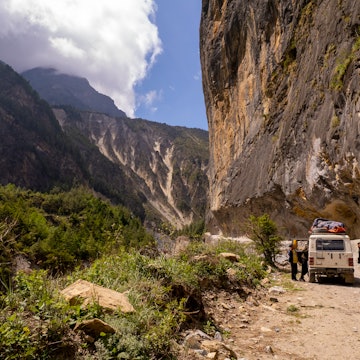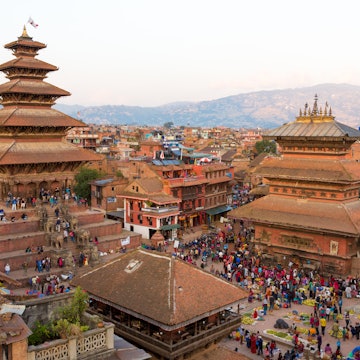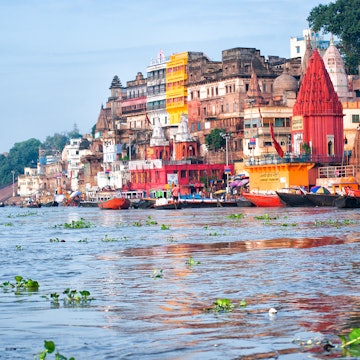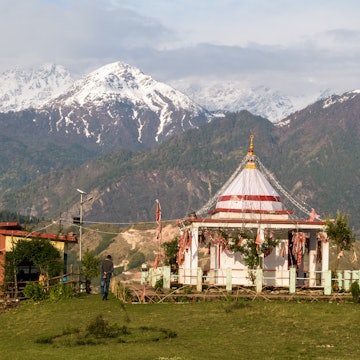

Dhankuta District in eastern Nepal. Sundar Photo/Shutterstock
Whenever I mention traveling to Nepal, people assume that trekking is on my itinerary. After all, Nepal has world-famous hiking trails and has been a mountaineering hot spot since the mid-20th century, and the country’s Himalayan hiking circuits – especially Mt Everest Base Camp – feature prominently on plenty of bucket lists. While I enjoy the odd tromp through the woods, I’m much more motivated to spend long hours crammed in an airplane if I know that culturally immersive experiences await me on the other side, and it doesn’t get more culturally immersive than being a guest in someone’s home.
Although I’ve spent a fair amount of time in Nepal over the years, my visits involved staying in guesthouses and eating in restaurants, primarily in the Kathmandu area. All of that changed on my most recent trip, during which I traded the big city for eastern Nepal’s Dhankuta District, a region better known for avocado and orange production than tourism. Climate change and resulting water scarcity concerns have made agricultural production more challenging, prompting the municipal government, with support from the intergovernmental International Centre for Integrated Mountain Development and the social enterprise Community Homestay Network (CHN), to invest in sustainable tourism initiatives.
That’s how I ended up at one of the network’s newest homestays, in the hillside village of Sipting on the outskirts of Dhankuta.




What is a homestay?
When I first heard of the homestay concept, I assumed it was similar to Airbnb or other short-term rental outfits, which you pay to stay in someone’s home for a night or two. How wrong I was!
When you stay with a CHN host, you’re truly a guest in their home, not just a person who’s crashing for the night. This means participation. A day in a homestay could involve anything from learning how to prepare popular snacks such as momos (stuffed dumplings) to simply hanging out and getting to know your hosts.
At my homestay, I tried my hand at crafting tapari, disposable dishes made by sewing hardy sal (shorea robusta) leaves together using thin, bendy bamboo twigs. My hosts made it look easy, deftly weaving together each little bowl in a matter of minutes. What I crafted looked more like a poorly executed child’s craft project, but it (sort of) worked as a plate.
Staying in a homestay also means delicious home-cooked food. While you can certainly expect to eat plenty of dal bhat (lentils and rice), a classic Nepali combination, you’ll likely also sample dishes that aren’t typically found in restaurants. In Sipting, I tried dhindo, a glutinous millet mash that pairs beautifully with veggies and dal – it’s similar in consistency to ugali (a staple made from maize or cassava flour, or both) found in parts of East Africa. I also tried tongba, a tasty (and mildly boozy) fermented millet drink traditionally served in a bamboo mug.
What are homestay accommodations in Nepal like?
Sleeping in a homestay, especially if you opt for a more off-the-beaten-path destination like I did, may feel pretty different from a night in a hotel, starting with the rooms. While soft spring mattresses are common in Nepali hotels, particularly those that get a lot of overseas guests, many homestays have either mattresses stuffed with coir (coconut husk fiber) or soft pads on a hard, solid-board bed. While this arrangement can be heavenly if you prefer a firm mattress, some people – notably side sleepers – might find that it takes a bit of getting used to.
Some homestays have squat toilets instead of sit-down toilets, especially outside of the Kathmandu Valley and Pokhara areas. Squat toilets don’t always have flush handles, which means you need to flush them manually (pour a small bucket of water right into the toilet and gravity will do the rest).
Many homes also have separate rooms for toilets and bathing. While stand-up showers are common, some homes rely on the eco-friendlier bucket bath method instead: fill a bucket with water and use a smaller jug to pour water over your body. Your homestay might not have hot tap water, but you can always ask your host to boil some for you – or you can enjoy the invigorating sensation of a cool water bath.


How do homestays benefit communities?
In rural Nepal, it’s traditional for women to stay at home while male family members go to work in fields or migrate to larger cities in search of income. Homestay hosting provides a means for women to make money from home. The presence of homestays also creates adjacent economic opportunities, ranging from driving to guiding. During my visit, my group went on hikes and excursions led by 22-year-old Nabin Rai, who grew up in the Dhankuta area and learned the ins and outs of guiding with the support of community training programs. While homestays exist in more visited parts of Nepal, they can also help curb overtourism by redirecting visitors to lesser-known areas – such as Dhankuta – that could benefit from tourism revenue.
How can I be a great homestay guest?
The first step to being a great guest is remembering that you’re staying in someone’s home, so observe what your hosts do and follow suit. It’s customary to take off your shoes before entering homes in Nepal, though many people wear house slippers. These dedicated flip-flops are meant only for indoor use, and most hosts will provide you with your own pair. Separate slippers are usually kept in front of bathrooms so you can change into them while you use the facilities.
It's also best to avoid entering any rooms that you haven’t specifically been invited into (although that’s a good rule to follow wherever you are). For example, my hosts were members of the Aathpahariya community. In their culture, kitchens are off-limits to outsiders (including Nepali people from other communities) for cultural and spiritual reasons.
While you might show appreciation at a hotel by leaving a cash tip for staff, it’s much better to bring a small gift for your host family, such as a trinket from your home country (if you’re uncertain, it’s best to clear your idea with your contact at CHN, especially if it’s a food item). It is, however, customary to tip drivers and guides, so keep some cash on hand, just in case
What do I pack for a homestay in Nepal?
If you book your homestay with CHN, you'll be sent a comprehensive packing list that takes into account the climate of the area you’re visiting. From a cultural perspective, it’s polite to stick to more modest clothes that don’t show a lot of skin; from a practical perspective, long trousers are a must to keep your legs protected during hikes. You'll also need a pair of solid shoes that are suitable for hiking and walking on uneven surfaces, as you will have to spend some time on your feet, likely on unpaved roads or trails.
A headlamp is another must for postsunset strolls or occasional power cuts. And don’t forget a refillable water bottle: all of the homestays provide safe drinking water (my homestay was equipped with filters provided by a social enterprise called SmartPaani, which helps communities develop and sustain their own potable water supplies).
How much does it cost to stay in a homestay in Nepal?
Homestays can be cheaper than hotels, and most cost 20–40 US dollars per night per person, including meals and some activities. Multiday excursions are available if you’re traveling in a group and include a mix of hiking, cultural activities, transportation and the chance to visit multiple homestays.
How can I book a homestay in Nepal?
While many tour operators and travel agents can arrange homestays for their guests, you can book directly through CHN’s online portal, which features an interactive map and detailed listings that include details on amenities and experiences.

Best regions for homestays in Nepal
Eastern Nepal
If you want to see a part of Nepal that doesn’t get a lot of international tourism, head to the east – but be prepared for a voyage. Getting to my homestay in Dhankuta required that I fly from Kathmandu to Biratnagar, then drive north for about three hours. While it was a bit of a journey, it was well worth the trip.
Kathmandu Valley
If you’re short on time but want a homestay experience without spending a lot of time in transit, look for a homestay in the Kathmandu Valley. Many of these homestays are well established (in fact, the oldest homestay in the network is in Panauti, a mere 32km outside of Kathmandu).
Pokhara and Annapurna
There are quite a few homestays in the Pokhara area, which are ideal if you’re planning to hike the famous Annapurna Circuit or one of the many other routes in the region.















